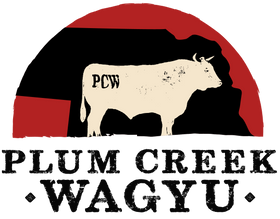A savory, hearty recipe for Wagyu Short Ribs.
INGREDIENTS
- 3 lbs bone-in Wagyu Beef Short Ribs
- Olive Oil
- Kosher Salt & Black Pepper
- 1 1/2 (one & one half) Cup Celery (chopped – 2–3 stalks)
- 1 Cup Yellow Onion (chopped)
- 1 Cup Carrots (chopped – usually 2–3 carrots)
- 3 Cloves Garlic (minced)
- 1/2 Bottle of Red Wine
- 2 Cups Beef Stock or Broth
- 1/2 Cup Canned Crushed Tomatoes
- 6 ounces Stout Beer
- 3 Sprigs Fresh Thyme, tied with kitchen string, plus more for garnish
INSTRUCTIONS
-
Preheat the oven to 425 degrees F.
-
Place Short Ribs on a sheet pan, brush the tops with olive oil, and sprinkle with ½ tablespoon salt and ¾ teaspoon pepper. Roast for 20 minutes, then remove from the oven. Reduce the temperature to 325 degrees F.
-
Meanwhile, heat 1/4 cup olive oil in a large Dutch oven, over medium high heat. Add the celery, onions, and carrots and cook until tender, about 15 minutes, stirring occasionally. Add the garlic and cook for one minute. Add the wine, bring to a boil, lower the heat, and simmer for a few minutes. Add the stock, tomatoes, Stout beer, thyme, ½ tablespoon salt, and ¾ teaspoons pepper.
-
Place the Short Ribs in the pot. Bring to a boil, cover, and cook in the oven for 1½ to 2 hours. Uncover and cook for one more hour, until the meat is very tender.
-
Remove the Short Ribs to a plate with a slotted spoon and discard the thyme bundle and bones. Simmer the sauce on the stove for 10 minutes. Skim the fat off the top and discard. Return the ribs to the pot, heat for 5 minutes, and taste for seasonings. Serve with garlic mashed potatoes and a garnish of fresh thyme sprinkled on top.
Related Posts
How We Select and Age Our Wagyu Beef for Optimal Flavor
Learn about the process of selecting and aging Wagyu beef at Plum Creek Wagyu. Discover the differences between dry-aging and wet-aging and how each method enhances the flavor and tenderness of our premium Wagyu cuts.
How We Select and Age Our Wagyu Beef for Optimal Flavor
Learn about the process of selecting and aging Wagyu beef at Plum Creek Wagyu. Discover the differences between dry-aging and wet-aging and how each method enhances the flavor and tenderness of our premium Wagyu cuts.
Sustainable Ranching at Plum Creek Wagyu: Our Eco-Friendly Practices
Discover Plum Creek Wagyu’s commitment to sustainability and eco-friendly ranching practices. Learn about our efforts in land stewardship, water conservation, and reducing our carbon footprint to produce premium Wagyu beef responsibly.
Behind-the-Scenes at Plum Creek Wagyu: From Pasture to Plate
Discover the life cycle of a Plum Creek Wagyu cow, from birth to plate. Learn about the care, feeding, and stress-free environment that contributes to the exceptional quality of our Wagyu beef.
Wagyu Beef vs. Kobe Beef: What’s the Difference?
Curious about the difference between Wagyu and Kobe beef? Learn how these two premium beef types differ in terms of origin, quality, and flavor, and discover why Kobe beef is considered the gold standard of luxury dining.
The Science Behind Wagyu Marbling: Why It’s So Special
What makes Wagyu beef so incredibly tender and flavorful? The secret lies in its marbling. Discover the science behind Wagyu’s signature fat distribution and why it creates the ultimate steak experience.








